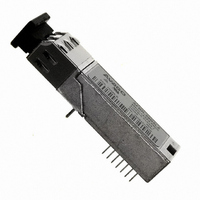AFBR-59R5LZ Avago Technologies US Inc., AFBR-59R5LZ Datasheet - Page 3

AFBR-59R5LZ
Manufacturer Part Number
AFBR-59R5LZ
Description
TXRX OPT SFF 4/2/1GBD 2X7
Manufacturer
Avago Technologies US Inc.
Datasheet
1.AFBR-59R5LZ.pdf
(20 pages)
Specifications of AFBR-59R5LZ
Data Rate
4.25GBd
Wavelength
850nm
Voltage - Supply
3.6V
Connector Type
LC
Mounting Type
Through Hole
Function
Digital Diagnostic SFP, supports high-speed serial links over multimode optical fiber.
Product
Transceiver
Maximum Rise Time
0.09 ns/0.15 ns
Maximum Fall Time
0.09 ns/0.15 ns
Pulse Width Distortion
0.06 ns (Max)/0.062 ns (Max)
Operating Supply Voltage
2.97 V to 3.63 V
Maximum Operating Temperature
+ 85 C
Minimum Operating Temperature
- 10 C
Package / Case
DIP With Connector
Lead Free Status / RoHS Status
Lead free / RoHS Compliant
Applications
-
Lead Free Status / Rohs Status
Lead free / RoHS Compliant
For Use With
Multimode Glass
Lead Free Status / RoHS Status
Lead free / RoHS Compliant, Lead free / RoHS Compliant
Other names
516-1995
Component Monitoring
The AFBR-59R5LZ real-time monitors of Tx_Bias, Tx_Pow-
er, Vcc, Temp and Rx Average Power may potentially be
used as a debugging aid for system installation and de-
sign, and transceiver parametric evaluation for factory or
field qualification. For example, temperature per module
can be observed in high-density applications to facilitate
thermal evaluation of blades and systems.
Transmitter Section
The transmitter section contains 850nm VCSEL (Vertical
Cavity Surface Emitting Laser) light source, located at the
optical interface which mates with the LC optical con-
nector. The VCSEL is driven by a custom IC which uses
the incoming differential (PECL compatible) high speed
logic signal to modulate laser diode driver current. This
Tx laser driver circuit regulates optical output power at a
constant level provided the incoming data pattern is dc
balanced (8B/10B code, for example).
Transmit Disable (Tx_Disable)
The AFBR-59R5LZ accepts a TTL transmit disable control
signal input which shuts down the transmitter. A high
signal implements this function while a low signal allows
normal transceiver operation. In the event of a fault (e.g.
eye safety circuit activated), cycling this control signal
resets the module as depicted in Figure 5. An internal
pull down resistor enables the laser if the line is not con-
nected on the host board. Host systems should allow
a 10ms interval between successive assertions of this
control signal. Tx_Disable can be asserted via the two-
wire serial interface (address A2h, byte 110, bit 6) and
monitored (address A2h, byte 110, bit 7).
The contents of A2h, byte 110 bit 6 are logic Or’d with the
TX_DISABLE pin to control the transmit output.
3
Eye Safety Circuit
The AFBR-59R5LZ provides Class 1 (single fault tolerant)
eye safety by design and has been tested for compliance
with the requirements listed in Table 1. The eye safety
circuit continuously monitors optical output power levels
and will disable the transmitter upon detecting an un-
safe condition beyond the scope of Class 1 certification.
Such unsafe conditions can be due to inputs from the
host board (Vcc fluctuation, unbalanced code) or a fault
within the transceiver.
Receiver Section
The receiver section contains a PIN photodiode and cus-
tom transimpedance preamplifier, located at the optical
interface which mates with the LC optical connector. The
output is fed to a custom IC that provides post-amplifica-
tion and quantization.
Signal Detect (Sig_Det)
The post-amplification IC also includes the transition
detection circuitry which monitors the ac level of incom-
ing optical signals and provides a TTL status signal to the
host. An adequate optical input results in high signal
detect output while a low signal detect output indicates
an unusable optical input. The signal detect thresholds
are set so that a low output indicates a definite optical
fault has occurred. Signal Detect can be monitored via
the two-wire serial (address A2h, byte 110, bit 1).
























